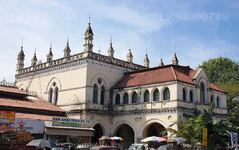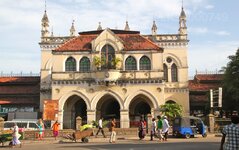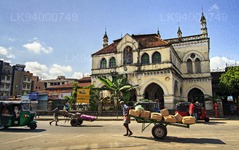
Colombo City
Colombo, the capital of Sri Lanka, is a dynamic city blending tradition and modernity. It showcases colonial architecture, lively markets, and serene Buddhist temples. With diverse cuisine, a growing skyline, and beautiful beaches, it's a vibrant hub for business, culture, and tourism, offering a gateway to explore Sri Lanka's wonders.
قاعة المدينة القديمة، كولومبو
Amongst the little known historic monuments of Colombo, is large gothic church-like mansion in the old business quarter of Pettah. People, both locals and tourists, pass it by with little thought to what it contains – a veritable treasure trove of artifacts. It vanishes among the landscape surrounded by equally dated buildings, colorful modern shops and other interesting pieces of architecture. The fact that it’s in one of the busiest sectors of the city doesn’t help. This building is the Old Town Hall, once the seat of the Colombo Municipality and was the main location for council meetings in Colombo.
History
The Old Town Hall was built in 1873, designed by the British architect J G Smither who also designed furniture to match, and was the first civic building to be opened in Colombo. The building was used as the municipal headquarters for over 50 years, until 1924. At the time thee was also a hall alongside it, used for the growth of the arts in the form of street plays and dramas – Edinburgh Hall. The hall was built at the same time and reflected several matching architectural features; such filigreed cast iron detailing, a slightly gothic design and etc.
In 1925, the Municipal Headquarters were moved to the current Town Hall, next to Viharamahadevi Park. With the change of premises, the Old Town Hall fell into dust and disuse; along with Edinburgh Hall, which was no longer the best location to show off the arts.
In 1980 the crumbling structure came to the notice of the president of the time, Premadasa, who renovated it by 1984 and turned it into one of Colombo’s historical attractions. The adjoining building was converted into a museum, and Edinburgh hall was turned into Edinburgh Market where street hawkers could ply their wares.
Within the Old Town Hall
There’s no entrance charge for visiting. So it’s basically just knock and enter. Once you enter the building, the first thing you notice are the motes of dust that glimmer in the dim light that comes in from the aged glass panes of the tall windows. A musty smell permeates the structure. The smell of time and history.
Some of the ground floor is still in use for government meetings. You may see some plainly furnished, but perfectly serviceable chairs and tables in such rooms that are in use. The lack of dust in these spaces is also a giveaway.
The sole caretaker of the large Old Town Hall will take you upstairs. Be ready for a mini freakout. Once you get to the top of the stairs, you’ll find yourself in a large open room with a conference table in the center. And here’s creepy part, there will be 15 men seated around the table in dated suits. It’s only closer inspection that will reveal them to be somewhat dusty life-sized wax figures. Each have a name card placed before them (including one W. Shakespeare?!), and some have strangely colorful neckties.
Other than this strange plateau; there are other life-sized statues of servants/butlers, paintings, and some old photographs. You can also view the city from the windows. Make sure to check the room to the side. It has some early typewriters, old radios, and the pièce de résistance – a 1785 map of Colombo. Once you come back down, make sure to visit the adjoining museum. It has a number of different artifacts; including ancient machinery, old metal street signs mounted on an equally old wooden post, antique boilers and timers, old light holders, an old mobile library vehicle, and a a giant lightbulb that lit the entire square outside the Old Town Hall.
There is much to see at the Old Town Hall; some quite interesting and unique, some not so much, and some downright strange. Whatever the case may be, this monument is definitely worth having a visit while in Colombo.
About Colombo District
Colombo is the largest city and commercial capital of Sri Lanka. It is located on the west coast of the island and adjacent to Sri Jayewardenepura Kotte, the capital city of Sri Lanka. Colombo is a busy and vibrant city with a mixture of modern life and colonial buildings and ruins and a city population of 647,100.The Colombo Metropolitan Region, defined by the districts of Colombo, Gampaha and Kalutara, has an estimated population of 5,648,000, and covers an area of 3,694.20 km²
Colombo is a multi-ethnic, multi-cultural city. It is the most populous city in Sri Lanka, with 642,163 people living within the city limits. The population of Colombo is a mix of numerous ethnic groups, mainly Sinhalese, Moors and Tamils. There are also small communities of people with Chinese, Portuguese, Dutch, Malay and Indian origins living in the city, as well as numerous European expatriates.
The great majority of Sri Lankan corporations have their head offices in Colombo. Some of the industries include chemicals, textiles, glass, cement, leather goods, furniture, and jewellery. In the city center is located South Asia's second tallest building - The World Trade Centre.
About Western Province
The Western Province is the most densely populated province of Sri Lanka. It is home to the legislative capital Sri Jayawardenepura Kotte as well to Colombo, the nation's administrative and business center. Western Province is divided into 3 main districts called Colombo (642 km²), Gampaha (1,386.6 km²) and Kalutara (1,606 km²) districts. As Sri Lanka's economic hub, all the major local and international corporations have their presence in the city and so do all the major designer and high street retailers, so be ready to indulge in some retail therapy in western province.
Having the highest population in the all the provinces, the almost all the premier educational institutions in the island are located in western province. Universities in the province include the University of Colombo, the University of Sri Jayewardenepura, University of Kelaniya, Open University, Sri Lanka, Buddhist and Pali University of Sri Lanka, General Sir John Kotelawala Defence University and University of Moratuwa .Western province has the largest amount of schools in the country, which includes National, Provincial, Private and International schools.







































